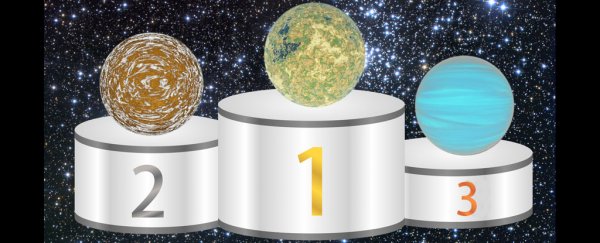The recent news of flowing salt water on the surface of Mars is a huge scientific discovery that vastly alters the prospects of finding alien life on the red planet. But it also tells us more about the conditions of Mars's water – a vital and powerful resource that we'd need to know a lot about if we're ever going to try living there.
But looking a little further than our own Solar System, how habitable are exoplanets in distant galaxies? Now we know, thanks to a new habitability index, which not only analyses the potential habitability of planets orbiting other stars, but can rank them on a planetary scale – helping us to know which worlds we should investigate first in the search for life beyond Earth.
"Basically, we've devised a way to take all the observational data that are available and develop a prioritisation scheme," said Rory Barnes, an astronomy professor with the University of Washington's Virtual Planetary Laboratory. "[S]o that as we move into a time when there are hundreds of targets available, we might be able to say, 'OK, that's the one we want to start with.'"
The conventional analysis of a star's habitable zone (aka the 'Goldilocks zone') looks at whether planets orbit within a region of space with sufficient atmospheric pressure to possess liquid water on their surface – and could thus potentially support life. The new, nuanced system, however, enables researchers to delve deeper into other habitability factors for worlds inside the zone.
"This innovative step allows us to move beyond the two-dimensional habitable zone concept to generate a flexible framework for prioritisation that can include multiple observable characteristics and factors that affect planetary habitability," said co-author Victoria Meadows.
The index looks at estimates of how rocky a planet is, and considers its 'eccentricity-albedo degeneracy', which balances how much energy the planet reflects from its surface against the circularity of its orbit, which affects how much energy it receives from the star it orbits.
As the researchers explain, these two energy transfers counteract one another, but the right balance between them creates a life-friendly energy equilibrium that makes for habitable conditions.
The most habitable planets – and therefore the best candidates for scientists to focus on in future research – are those that get between 60 to 90 percent of the solar radiation that Earth receives from the Sun. With the new, granular index in place, it will be quicker for astronomers to find whether planets fit these criteria.
"[The habitable zone] was a great first step, but it doesn't make any distinctions within the habitable zone," Barnes said. "Now it's as if Goldilocks has hundreds of bowls of porridge to choose from."
The paper has been accepted for publication in The Astrophysical Journal.
